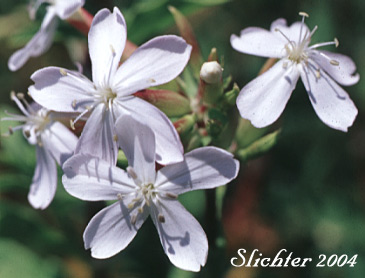

 The
photo at right shows the long tubular corolla with flaring lobes of soapweed.
Photographed at Horsethief Butte in the Columbia River Gorge several miles northeast
of The Dalles Dam..........July 2002.
The
photo at right shows the long tubular corolla with flaring lobes of soapweed.
Photographed at Horsethief Butte in the Columbia River Gorge several miles northeast
of The Dalles Dam..........July 2002.
Soapweed, also known as bouncing bet, is pretty wildflower with several to many sprawling to erect stems from 50-100 cm high. The herbage of the stems and leaves is glabrous. The simple, leafy stems may bear as many as 20 pairs of opposite leaves which are narrowly elliptic in shape (See photo.) with both ends tapering to a point. The blades are 3-nerved short-petioled and 6-10 cm long and 1.5-4 cm wide. The plants easily spread via rhizomes
The inflorescence is a congested cyme of many flowers. The tubular calyx is glabrous and about 2 cm long. It becomes somewhat elliptic in shape when in fruit. The fragrant flowers are light rose-color or white, with with the lower section a tube that is slightly longer than the calyx. The blades of the petals are perpendicular to the tube, obovate to wedge-shaped, and from 8- 15 mm long. Both the two styles and 10 stamens are exserted from the throat of the flower.
Soapweed has been used as a flower for gardens. It is hardy and needs little attention, although it probably looks better mixed in with other wildflowers. Plants in the shade tend to sprawl and it does spread fairly easily.
It is reported that soapweed was originally planted by pioneers who knew that one could create a soapy lather by bruising the leaves or stems of the plant in water. Evidently the plant's lather was more effective for cleaning their finer fabrics than the homemade or local soaps available at that time!
Soapweed is also reported to be toxic to livestock although it is reportedly seldom grazed.
Soapweed maybe found as an escaped plant in gardens, disturbed streambanks, and disturbed roadsides and ditches.
Native to Europe, soapweed has been introduced to America as an ornamental plant and has escaped to become widely established across much of Washington and Oregon.